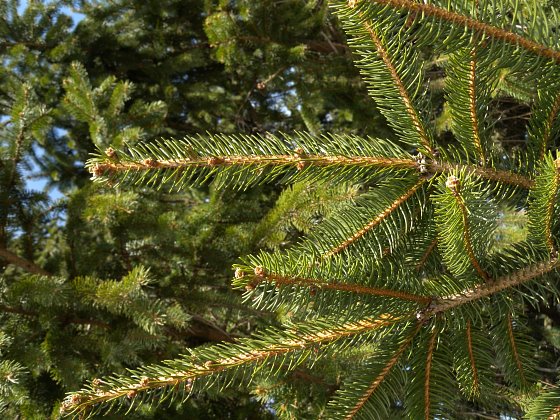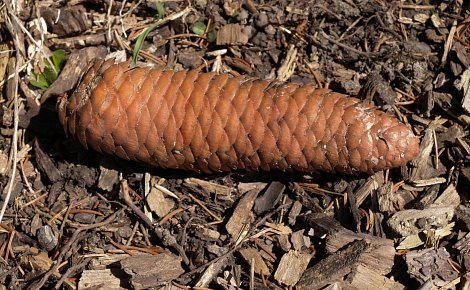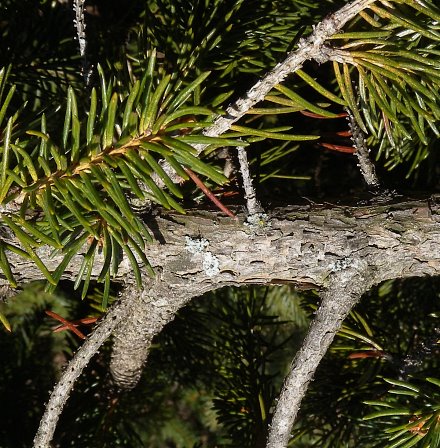
Norway Spruce is monoecious, forming separate male and female cones on the same tree during mid- to late spring. Male pollen cones are produced from the axils of the needle-like leaves; they are ½-1" in length, oblongoid-ovoid in shape, and purplish red to whitish pink. Female seed cones are produced from the tips of twigs; they are initially pink to reddish pink and oblongoid-ovoid in shape, but change color and become longer after the blooming period. At this stage, both male and female cones are more or less erect. Afterwards, fertile seed cones become green and hang downward; they are covered with overlapping appressed scales. At maturity, these seed cones become brown to gray-brown and slightly woody from their thin scales; they are 4-7" in length and cylindrical in shape. Individual scales are about ¾-1" in length and ½-¾" across; they are obovate-rhombic in shape, glabrous, and irregularly toothed to toothless along their outer margins. Hidden behind each scale, is a pair of winged seeds (not always fully developed). Each seed body is 3-5 mm. in length, while its membranous wing is 10-15 mm. in length. The winged seeds are distributed by the wind. The root system consists of
Cultivation: The preference is partial to full sun, well-drained moist conditions, and an acidic fertile soil consisting of sandy loam or other soil types. A cool, moist, and humid climate is also preferred, although this tree can tolerate a temperate climate that is more warm and dry. Growth is relatively fast for a conifer during the early stages of development. Under favorable conditions in North America, this tree will live 100-200 years, if not longer. Where the soil has a low pH, it is vulnerable to acid rain.
Range & Habitat: The non-native Norway Spruce has naturalized only in the NW corner of Illinois in Jo Daviess County, where it is rare. It was introduced into North America from Europe, where it is native. In Illinois, this tree has naturalized in a woods (Mohlenbrock, 2002), where it is apparently successfully reproducing. Norway Spruce is far more common in cultivation, where it used as a landscape tree, a windbreak tree, and a plantation tree (for Christmas trees and other commercial markets).
Faunal Associations: Several kinds of insects bore through the wood, suck plant juices, feed on the foliage, or feed on the seeds of spruce trees (Picea spp.), including Norway Spruce. These insects include larvae of the Spruce Beetle (Dendrotonus rufipennis) and larvae of other bark beetles, larvae of the Violet Tanbark Beetle (Callidium violaceum) and larvae of other long-horned beetles, White Pine Weevil (Pissodes strobi) and other weevils, Atractotomus magnicornis and other plant bugs, Pineapple Gall Adelgid (Adelges abietis) and other Adelgid aphids, Green Spruce Aphid (Cinara fornacula) and other aphids, Pine Needle Scale (Chionaspis pinifoliae) and Spruce Bud Scale (Physokermes piceae), larvae of the Conifer Sawfly (Acantholyda maculiventris), larvae of the White-horned Horntail (Urocerus albicornis) and other horntail wasps, European Conifer Thrips (Thrips pini), and larvae of such moths as the Orange Spruce Needleminer (Coleotechnites piceaella), Large Purplish Gray (Anacamptodes vellivolata), Variegated Midget (Elaphria versicolor), Eastern Panthea (Panthera furcilla), Spruce Seed Moth (Cydia strobilella), and Spruce Budworm (Choristoneura fumiferana). The Insect Table provides a more complete list of these insect feeders. An arachnid species, the Spruce Spider Mite (Oligonychus ununguis), also feeds on these trees.

The seeds of spruce trees are eaten by such birds as the Red Crossbill, White-winged Crossbill, Red-breasted Nuthatch, Evening Grosbeak, Pine Siskin, Black-capped Chickadee, and Hairy Woodpecker. In addition, many species of birds, especially warblers, use these trees for protective cover and nesting habitat (see Bird Table). The foliage and twigs are browsed by the American Moose and White-tailed Deer to some extent, while the North American Porcupine feeds on the bark and wood. Some tree squirrels, such as the Eastern Gray Squirrel and especially the American Red Squirrel, also eat the seeds (Martin et al., 1951/1961; Ludewig & Bowyer, 1985). The dense foliage, exfoliating bark, or cavities of spruce trees make them attractive as daytime roost sites for some species of bats. This includes the Little Brown Bat (Myotis lucifugus), Northern Long-eared Bat (Myotis septentrionalis), and Hoary Bat (Lasiurus cinereus); see Lowe (2012) and Willis & Brigham (2005).
Photographic Location: Near the veterinarian building of the University of Illinois in Urbana, Illinois.

Comments: The wood of Norway Spruce is used to make furniture, musical instruments (pianos & violins), pulp, and in general construction. It is light-colored, light-weight, rather soft, and reasonably strong. Norway Spruce has the longest seed cones of any spruce (Picea sp.) in Illinois; they exceed 4" in length, while the seed cones of other spruces within the state (which are largely cultivated) are less than 4" in length. Spruces resemble firs (Abies spp.), but their mature seed cones hang downward from their branches. In contrast, the mature seed cones of firs are erect. Spruces produce their leaves individually along their twigs and branches, while pines (Pinus spp.) produce their leaves in clusters (typically 2-5 leaves per cluster). Thus, spruces are fairly easy to distinguish from firs and pines. Like Norway Spruce, other spruces in Illinois are rarely observed in the wild. The coniferous trees in this group are more typical of boreal regions or mountainous areas where the climate is more cool and damp.